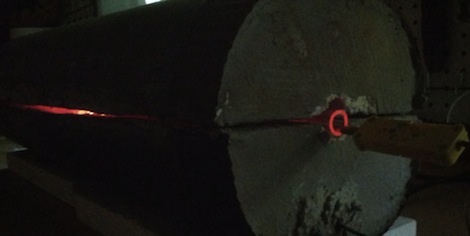What better way to spend a few months in the workshop than by heating Copper chloride to 400° C, building rotary spark gaps and 30kV capacitors, playing with high vacuums and building a very powerful laser? It’s just a day in [Jon]’s life as he builds a DIY Copper vapor laser.
Copper vapor lasers require temperatures of about 1500° C, but this is only when using pure Copper. Compounds such as Copper chloride are able to bring the required temperatures for lasing down to about 400° C, a reasonable temperature for [Jon]’s home built laser tube furnace. The only problem with this setup is the requirement for two electrical pulses, one to disassociate the Copper and a second to make the Copper lase.
The professional way of creating these electrical pulses would be a Thyratron, but it seems [Jon] wanted something cooler. He built a rotary spark gap out of two 2 inch thick blocks of acrylic that allow him to perfectly time the frequency and separation of the electrical pulses needed for his laser.
There is no word on exactly how much power [Jon]’s Copper vapor laser will put out when it’s complete, but [Jon]’s build log is already an amazing display of awesome. You can check out a short video showing off [Jon]’s laser, spark gap, and huge home-made capacitor after the break.
[youtube=http://www.youtube.com/watch?v=JeQPHVg2Bbg&w=470]

















Calling this a hack doesn’t do it justice, I think. Amazing work!
And it appears from the spell-check results that Gospodin Benchoff knows someone by the last name of Copper — well, we shouldn’t fuss, at least he’s using spell-check at last!
It’s a chemical element, therefore capitalized.
Not in any style guide I’ve ever run across, and I gather IUPAC abandoned the practice ca. 2004 (PDF, pg. 80). No need to be picky, tho, I suppose.
OOOH!!! I LOVE big thinkers. This is so far outside of normal ‘home hobby’ builds it’s a thousand times cooler!
Gotta follow this!
Not to pick nits, but any thyristor will work as a trigger device. He just happens to use a thyratron. If you can source an appropriately rated SCR, that would do the trick just as well.
I’ve never seen a 20-30kV @ 1000 amps (peak) rated SCR, but not discounting their existence either. I’m sure they’d be out of my budget laser range.
Well that’s got to be a contender for Hackaday feature of the year. Incredible!
Thank you Brian/HaD for posting my project. I was a bit surprised to see it as I’m still working on it but pretty cool to be featured nonetheless!
You deserve to be on here, without a doubt! Enjoy your well deserved moment of fame!
Any radio operators within several tens of miles of you probably hate you very much for that rotating spark gap :P
You’d think this guy could find a camera to use that wasn’t a piece of garbage.
Sorry, it was on loan from one of those ghost hunter shows. ;)
Probably has something to do with that spark gap generator…
:)
Where did the video go?
Its there for me.
Pew pew!
Seriously! How am I the first person to say this?
Amazying feat of pure marvel, I admire you time and dedication!
Any chance we could get a couple more videos or some better details of the setup?
Thank you! It’s an ongoing project so I will be updating as I go. I’m headed out of town for a week (any HaD folks going to IRCHA Jamboree?) but I will be updating more once I’m back.
Sweet the last time i have seen a Cooper-laser with spark-gap was in the 1980s in an issue of “Spektrum der Wissenschaft” as Build instruction. The cap back then was a few meters of tinfoil. Iirc it has some KW power so this one should have similar specs.
Awesome work! All you need now is a way to attach it to the shark.
Efficiency FTMFW!
Megawatts in, milliwatts out.
Copper(vapor/chloride/brome) can be fairly efficient for a non-solid state laser, about 1% commercially and as high as 3% in a lab setting. 10mW optical out per Watt in. 1kW in should yield about 10 Watts out. Peak pulse powers are several hundreds of kW but very short pulse times.
Compare that to other gaseous laser efficiencies and it’s not too bad. Co2 is around 200mW optical out/Watt in (~20% efficient). Argon ion is .0006w(600uW) optical out/Watt in (.06% efficient, that’s 20kW in to get 12 Watts out, ouch!) Helium neon lasers are about 0.3%
Diode lasers are of course much more efficient, but they don’t offer very interesting core technology builds (though you can use them as a primary pump source for a Nd:YAG or fiber laser, etc) since semiconductor fab is beyond most hobbyist capabilities.
Hmmm… As the reburn chamber of even a basic rocket stove can easily hit 1800F, I wonder if a more efficient design could be used to make a wood-fired laser!
This was a project in the back of Scientific American back in the mid ’80’s…